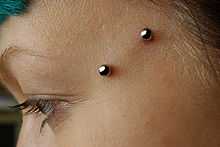Surface piercing

Surface piercings are any body piercings that take place on the surface sewn into the body through areas which are not particularly concave or convex, where the piercing canal transverses a surface flap of skin, rather than running completely through a piece of body tissue from one side to another. A surface bar follows the plane of skin, while a standard piercing is pierced through the plane.
Sometimes surface piercings are difficult to heal, because, as the body rejects the body jewelry as a foreign object, the jewelry is pushed to the surface, causing the piercing to grow out (also called rejection).[1] Proper placement and jewelry selection by an experienced body piercer can help alleviate this problem. A well done surface can last anywhere between 3 months, several years or indefinitely.
The best jewelry to be used in a surface piercing is a surface bar, though some might have success with PTFE bar due to its flexibility.
Types of Piercings
Some more common, surface piercings are:
- Corset piercing, a series of bilaterally symmetrical piercings, normally done on the back, intended to be laced like a corset.
- Christina piercing, located at the mons pubis.
- Madison piercing, a horizontal piercing located just above the collarbone, at the base of the neck.
- Nape piercing, located on the back of the neck.
- Neck piercing, located on the side of the neck. (Also called 'Vampire Bites')
- Hip piercing, located on or beside the hips (on the pelvis near the hips bones).
- Sternum piercing, located vertically or horizontally on the sternum.
- Wrist piercing, located on or near the wrist, generally on the upper side.
- Anti-eyebrow, located under the eye, or beside
Rejection
The body resists foreign objects inside itself, and that includes piercings. Rejection occurs when it is "easier" for the body to push the piercing out like a splinter than it is to heal a fistula (skin tunnel) around it. You can spot rejection happening when there is abnormal redness around the piercing and then after a while, you can start to see the jewelry through the skin. Additionally as a recipient of a piercing you can recognize rejection or infection as a general warmth, irritation or an itchy sensation. As soon as you notice or think you notice rejection happening go to a professional body piercer or general practitioner immediately. Rejection can be dangerous and could be indicative of serious infection. Rejection is common among piercings including surface piercings, navel piercings, eyebrow piercings among others.
Rejection is affected by placement, blood flow, irritation and abuse, as well as general health. The healthier a person is, the less likely problems may arise. Commonly known as piercing rejection syndrome.[citation needed]
Cleaning
To help decrease the chance of rejection, cleaning a surface piercing regularly is a good idea. The best way to clean it is to use a saline solution or non-iodized sea salt solution. Be careful not to agitate the piercing. The piercing should be cleaned a few times a day for the first few weeks.
Avoid rubbing alcohol, Peroxide, Bactine, or any kind of ointment.
References
External links
- BMEZine page on Surface Piercing Rejection - Explanation of various types of surface piercing techniques and rejection with several photos of piercings in the process of being rejected.
- Body piercing aftercare
| ||||||||||||||||||||||||||